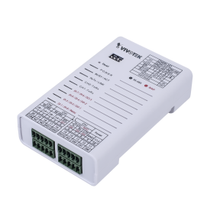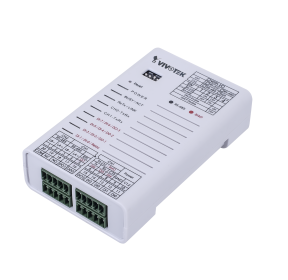Vivotek AO-20W Features
Hardware
- TCP Server 10/100 Mbps Base T Ethernet <--> RS485 (Auto-detection by order: RS232, RS232+RS485)
- Server Port 0 Baud rate: 2400 bps - 115200 bps, Support TCP/Server, TCP/Client, UDP mode
- Server Port 1 Baud rate: 2400 bps - 115200 bps, Support TCP/Server, TCP/Client, UDP mode
- Maximum Wiegand Output Up to 96 bits
- PoE No
General
- Connectors Digital input x 8, Digital output x 4: relay output x1 & digital output x3 (DO1, DO2 = WG data 1, data 0 when using Wiegand protocol)
- LED Indicator 9 LEDs for power, communication
- Power Input DC 9 ~ 24V
- Power Consumption Max. 2W
- Dimension 106.5 (L) x 66.3 (W) x 27.7 (H) mm
- Weight 86 (±5) g
- Safety Certifications FCC, CE, RoHs
- Starting Temperature: -25°C ~ 85°C (14°F ~ 185°F)
- Working Temperature: -20°C ~ 65°C (-4°F ~ 149°F)
- Humidity Storage: 5% ~ 95%, Working: 20% ~ 90%
- Buffer 1K each channel
- Surge Protection Power: 30 Volt, bi-directional avalanche breakdown device, RS485 6.5 Volt, bi-directional avalanche breakdown device, 400W peak power dissipation, Clamping time < 1 picosecond (theoretical)
- Fuse Protection Power PTC 150mA / RS485 PTC 30mA
Software
- Software Setting 701Server, 701Client HTTP web browser
- Operating System Windows 7/8/10, Win Server 2008/2012/2016
- Watchdogs Yes, build in watchdog for system error handling
Vivotek AO-20W Overview
The Wiegand protocol is commonly used in traditional access control systems, which grant access to drivers based on their badge with valid Wiegand ID numbers. In order to easily upgrade existing access control systems with the power of VIVOTEK LPR cameras, VIVOTEK’s onboard ANPR software can link license plates to specific Wiegand ID numbers (eg. driver’s badge). In the meantime, the VIVOTEK Wiegand converter can convert the Ethernet signal to Wiegand output signal in order to work with the existing access control system.
Moreover, with VIVOTEK’s ANPR software, you can also easily configure a mapping list to link plate numbers to specific ID numbers and set specific actions to individual groups.






